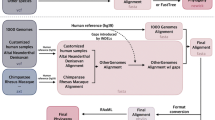Abstract
In forensic science, as well as in molecular anthropology and medical genetics, human mitochondrial DNA (mtDNA) variation is being recorded by aligning mtDNA sequences to the revised Cambridge reference sequence (rCRS). This task is straightforward for the vast majority of nucleotide positions but appears to be difficult for some short sequence stretches, namely, in regions displaying length variation. Earlier guidelines for imposing a unique alignment relied on binary alignment to a standard sequence (the rCRS) and used additional priority rules for resolving ambiguities. It turns out, however, that these rules have not been applied rigorously and led to inconsistent nomenclature. There is no way to adapt the priority rules in a reasonable way because binary alignment to a standard sequence is bound to produce artificial alignments that may place sequences separated by a single mutation at mismatch distance larger than 1. To remedy the situation, we propose a phylogenetic approach for multiple alignment and resulting notation.
Similar content being viewed by others
References
Anderson S, Bankier AT, Barrell BG, de Bruijn MH, Coulson AR, Drouin J, Eperon IC, Nierlich DP, Roe BA, Sanger F, Schreier PH, Smith AJ, Staden R, Young IG (1981) Sequence and organization of the human mitochondrial genome. Nature 290:457–465
Andrews RM, Kubacka I, Chinnery PF, Lightowlers RN, Turnbull DM, Howell N (1999) Reanalysis and revision of the Cambridge reference sequence for human mitochondrial DNA. Nat Genet 23:147
Bandelt H-J, Richards M, Macaulay V (eds) (2006) Human mitochondrial DNA and the evolution of Homo sapiens. Series: Nucleic Acids and Molecular Biology, vol. 18. Springer, Berlin Heidelberg New York
Bär W, Brinkmann B, Budowle B, Carracedo A, Gill P, Holland M, Lincoln PJ, Mayr W, Morling N, Olaisen B, Schneider PM, Tully G, Wilson M (2000) DNA Commission of the International Society for Forensic Genetics: guidelines for mitochondrial DNA typing. Int J Legal Med 113:193–196
Bendall KE, Sykes BC (1995) Length heteroplasmy in the first hypervariable segment of the human mtDNA control region. Am J Hum Genet 57:248–256
Brandstätter A, Parson W (2003) Mitochondrial DNA heteroplasmy or artefacts—a matter of the amplification strategy? Int J Legal Med 117:180–184
Brandstätter A, Niederstätter H, Parson W (2004) Monitoring the inheritance of heteroplasmy by computer-assisted detection of mixed basecalls in the entire human mitochondrial DNA control region. Int J Legal Med 118:47–54
Budowle B, Allard MW, Fisher CL, Isenberg AR, Monson KL, Stewart JE, Wilson MR, Miller KW (2002) HVI and HVII mitochondrial DNA data in Apaches and Navajos. Int J Legal Med 116:212–215
Carracedo A, Bär W, Lincoln P, Mayr W, Morling N, Olaisen B, Schneider P, Budowle B, Brinkmann B, Gill P, Holland M, Tully G, Wilson M (2000) DNA Commission of the International Society for Forensic Genetics: guidelines for mitochondrial DNA typing. Forensic Sci Int 110:79–85
Ewans WJ, Grant GR (2001) Statistical methods in bioinformatics. Springer, Berlin Heidelberg New York
Forster L, Forster P, Lutz-Bonengel S, Willkomm H, Brinkmann B (2002) Natural radioactivity and human mitochondrial DNA mutations. Proc Natl Acad USA 99:13950–13954
Kivisild T, Reidla M, Metspalu E, Rosa A, Brehm A, Pennarun E, Parik J, Geberhiwot T, Usanga E, Villems R (2004) Ethiopian mitochondrial DNA heritage: tracking gene flow across and around the gate of tears. Am J Hum Genet 75:752–770
Kong Q-P, Yao Y-G, Sun C, Bandelt H-J, Zhu C-L, Zhang Y-P (2003) Phylogeny of East Asian mitochondrial DNA lineages inferred from complete sequences. Am J Hum Genet 73:671–676; erratum (2004) 75:157
Kong Q-P, Bandelt H-J, Sun C, Yao Y-G, Salas A, Achilli A, Wang C-Y, Zhong L, Zhu C-L, Wu S-F, Torroni A, Zhang Y-P (2006) Updating the East Asian mtDNA phylogeny: a prerequisite for the identification of pathogenic mutations. Hum Mol Genet 15:2076–2086
Lutz S, Weisser HJ, Heizmann J, Pollak S (1997) A third hypervariable region in the human mitochondrial D-loop. Hum Genet 101:384
Lutz S, Weisser H-J, Heizmann J, Pollak S (1998) Location and frequency of polymorphic positions in the mtDNA control region of individuals from Germany. Int J Legal Med 111:67–77; errata (1998) 111:286 and (1999) 112:145–150
Monson KL, Miller KWP, Wilson MR, DiZinno JA, Budowle B (2002) The mtDNA population database: an integrated software and database resource for forensic comparison. Forensic Sci Commun 4:#2
Parson W, Parsons TJ, Scheithauer R, Holland MM (1998) Population data for 101 Austrian Caucasian mitochondrial DNA d-loop sequences: application of mtDNA sequence analysis to a forensic case. Int J Legal Med 111:124–132
Pfeiffer H, Lutz-Bonengel S, Pollak S, Fimmers R, Baur MP, Brinkmann B (2004) Mitochondrial DNA control region diversity in hairs and body fluids of monozygotic triplets. Int J Legal Med 118:71–74
Saillard J, Forster P, Lynnerup N, Bandelt H-J, Nørby S (2000) mtDNA variation among Greenland Eskimos: the edge of the Beringian expansion. Am J Hum Genet 67:718–726
Sun C, Kong Q-P, Palanichamy Mg, Agrawal S, Bandelt H-J, Yao Y-G, Khan F, Zhu C-L, Chaudhuri TK, Zhang Y-P (2006) The dazzling array of basal branches in the mtDNA macrohaplogroup M from India as inferred from complete genomes. Mol Biol Evol 23:683–690
Tanaka M, Cabrera VM, González AM, Larruga JM, Takeyasu T, Fuku N, Guo LJ, Hirose R, Fujita Y, Kurata M, Shinoda K, Umetsu K, Yamada Y, Oshida Y, Sato Y, Hattori N, Mizuno Y, Arai Y, Hirose N, Ohta S, Ogawa O, Tanaka Y, Kawamori R, Shamoto-Nagai M, Maruyama W, Shimokata H, Suzuki R, Shimodaira H (2004) Mitochondrial genome variation in eastern Asia and the peopling of Japan. Genome Res 14:1832–1850
Tully G, Bär W, Brinkmann B, Carracedo A, Gill P, Morling N, Parson W, Schneider P (2001) Considerations by the European DNA profiling (EDNAP) group on the working practices, nomenclature and interpretation of mitochondrial DNA profiles. Forensic Sci Int 124:83–91
Wilson MR, Allard MW, Monson KL, Miller KWP, Budowle B (2002a) Recommendations for consistent treatment of length variants in the human mtDNA control region. Forensic Sci Int 129:35–42
Wilson MR, Allard MW, Monson KL, Miller KWP, Budowle B (2002b) Further discussion of the consistent treatment of length variants in the human mitochondrial DNA control region. Forensic Sci Commun 4:#4
Acknowledgment
We are indebted to Anita Brandstätter, Nina Duftner, Cordula Eichmann, Anna König, Daniela Niederwieser, and Bettina Zimmermann (Institute of Legal Medicine, Innsbruck Medical University) for their excellent technical work and sequence analysis. Thomas J. Parsons (International Commission on Missing Persons, Sarajevo, Bosnia-Herzegovina) and Jodi A. Irwin (Armed Forces DNA Identification Laboratory) are greatly acknowledged for their helpful discussions. We thank Claudio Bravi for drawing our attention to the alignment problems in the Navajo mtDNA dataset. Finally, we appreciated the constructive criticism of one reviewer that helped improve the text.
Author information
Authors and Affiliations
Corresponding author
Rights and permissions
About this article
Cite this article
Bandelt, HJ., Parson, W. Consistent treatment of length variants in the human mtDNA control region: a reappraisal. Int J Legal Med 122, 11–21 (2008). https://doi.org/10.1007/s00414-006-0151-5
Received:
Accepted:
Published:
Issue Date:
DOI: https://doi.org/10.1007/s00414-006-0151-5




